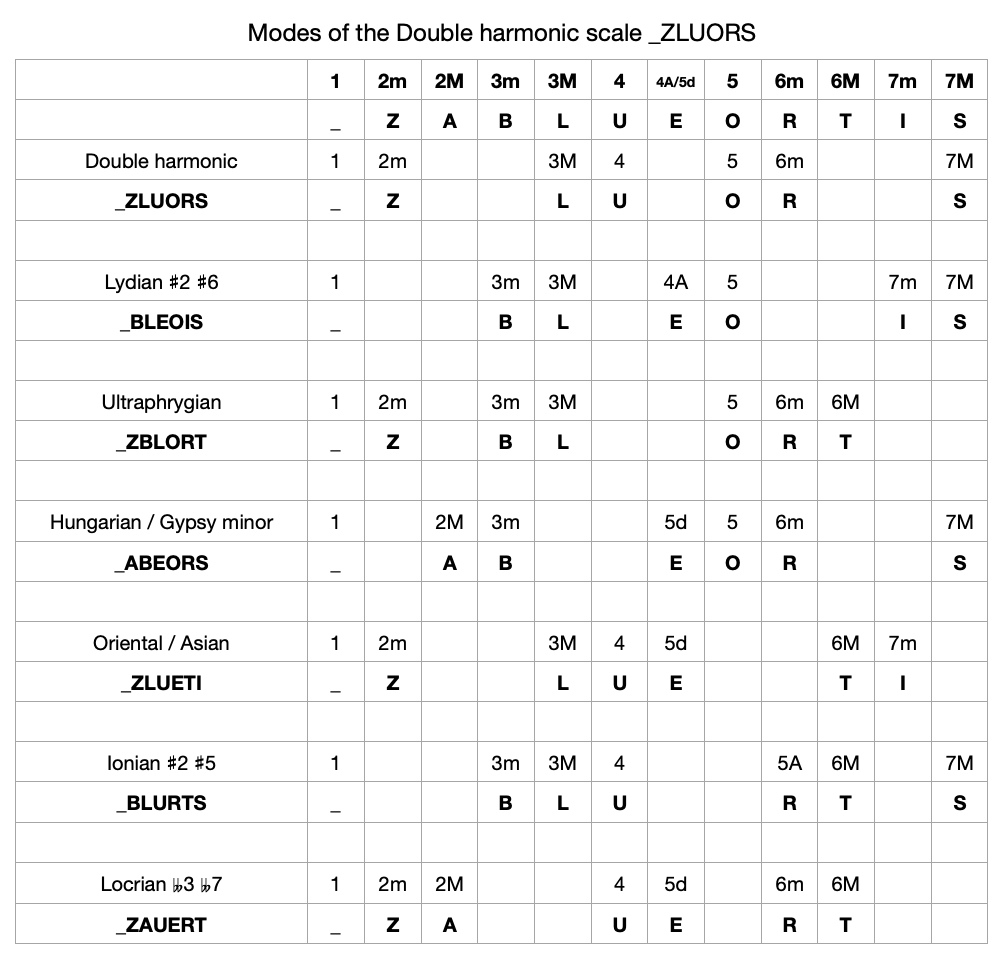_ Z A B L U E O R T I S
Universal system for naming musical scales with a precise meaning.
Project conceived by Nicolas Augsburger Rossi in 2022
www.arn-music.ch
Thoughts behind _ZABLUEORTIS:
Names: when it comes to choosing the name, especially for a daughter or a son, we look for its meaning, an information about it. All the names, classic and otherwise, were new on some day. You will discover new names generated by the _ZABLUEORTIS system. These names may sound strange and funny but they don't exist by chance, they all have meanings that exactly define the associated scale. The more you see them, the more they become evident.
By studying musical scales we must learn their names and associate the degrees of the scale in question by heart. It has always worked but the name itself indicates little or nothing about the construction of the scale, it is mainly a work of memory.
_ZABLUEORTIS, on the other hand, is designed to inform by precisely associating the name of the scale, which can be pronounced almost always and by almost everyone, with no translation necessary. Seeing the name of the scale, simply match the letters of the name with the keyword and the degrees of the scale appear. It is also important that the keyword is relatively easy to remember. Just remember _ZABLUEORTIS and it is possible to find and understand any scale. _ZABLUEORTIS is currently the unique one-to-one (biunivocal or bijective) way for naming all the musical scales.

A scale is a selection of degrees. _ZABLUEORTIS corresponds to the chromatic scale because it contains all 12 degrees. All other scales contain fewer degrees, so all other names are made up of fewer letters.
The first degree of the scale bears the name of the root, that is the initial note. For this reason grade 1 is represented by _ which will be replaced or preceded (free choice) by the name of the root.
Example: I want to play the natural minor scale starting from C♯. The scale is C♯_ABUORI.
The underscore is a prefix that allows the user to know the context of the characters that follow, such as a hashtag. It means the name has a _ZABLUEORTIS origin. (Thanks to Ian Ring from ianring.com for this consideration)
The degrees of the scale:
_ = 1 = Name of the root
Z = ♭2
A = 2
B = ♭3
L = 3
U = 4
E = ♯4 / ♭5
O = 5
R = ♯5 / ♭6
T= 6
I = ♭7
S = 7
Example: What is the difference between Ionian and Mixolydian? Until now it was necessary to know these scales by heart.
If we ask the same question: What is the difference between _ALUOTS and _ALUOTI ?
In this case the only difference is obvious: it is on the last degree. The last degree of the first is S = 7 while the last degree of the second is I = ♭7
The system was not designed to replace the classic names of the scales but to integrate in a complementary and universal way regardless of the language used. For example, the Bluesy Rock 'n Roll scale carries a rather vague name. By indicating Bluesy Rock 'n Roll _BLUOTI the user receives a precise information.
Why is the first letter of _ZABLUEORTIS is Z and not A? Because the 2nd degree of the most common scales is predominantly 2 or higher (see the tables below). It is simply for a pronunciation reason.
Names without vowels:
The longest non-vowel scale is _ZBLRTS = 1 - ♭2 - ♭3 - 3 - ♭6 - 6 - 7
It's not a very common scale but it does exist. In these cases it is better to spell.
Results with the 7 modes of the Major scale _ALUOTS. I voluntarily left the names of the scales in Italian, the system is universal.

Results with other scales:

Results with the seven modes of the Double harmonic scale:
In this example it is interesting to note that certain scales have a classical name with a precise indication of the alterations (example Ionian ♯2 ♯5 = Major scale for which the degrees 2 and 5 are increased by a semitone, so starting from _ALUOTS: A becomes B and O becomes R. _ALUOTS becomes _BLURTS), and other scales have a name that does not indicate anything about the scale structure, such as Hungarian or Oriental / Asian. In these cases the _ZABLUEORTIS system is particularly useful.

Blues scales:

Bebop scales:

Using the ARN-Music Apps, you will see the real advantage of this system, especially when you select degrees of a scale that is not registered in the list. If you like the scale, write down the name so you can easily find it when you need it.